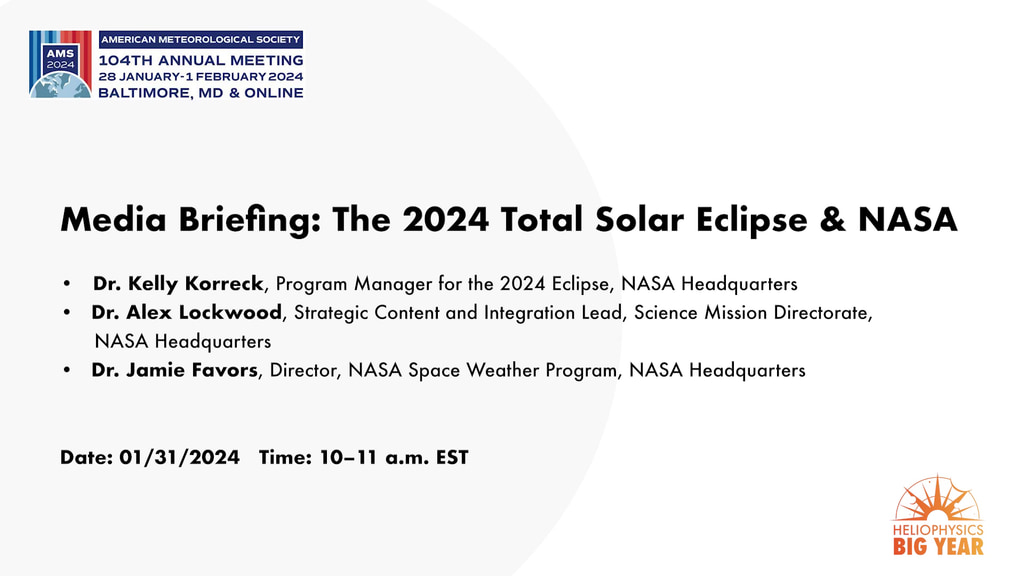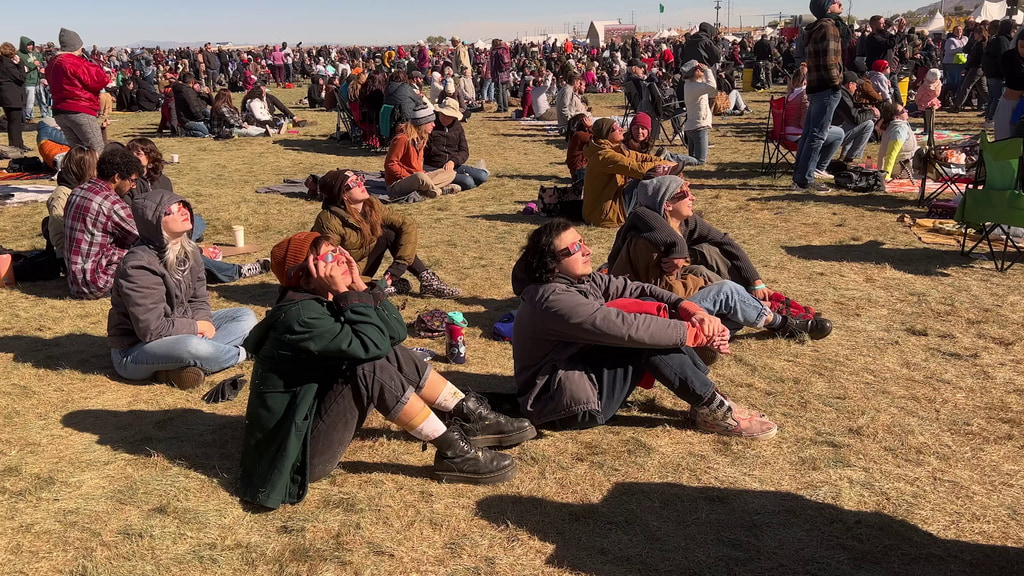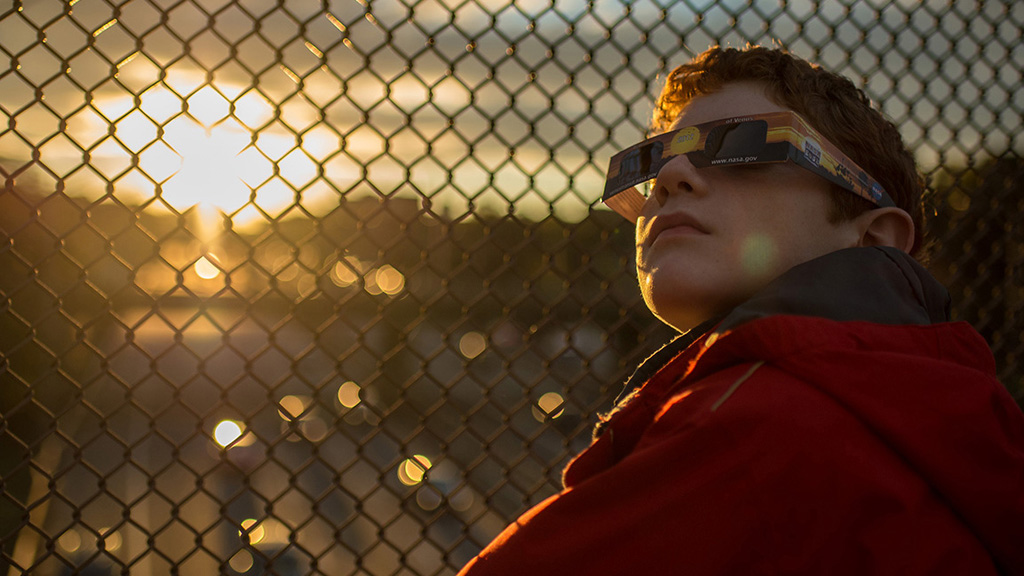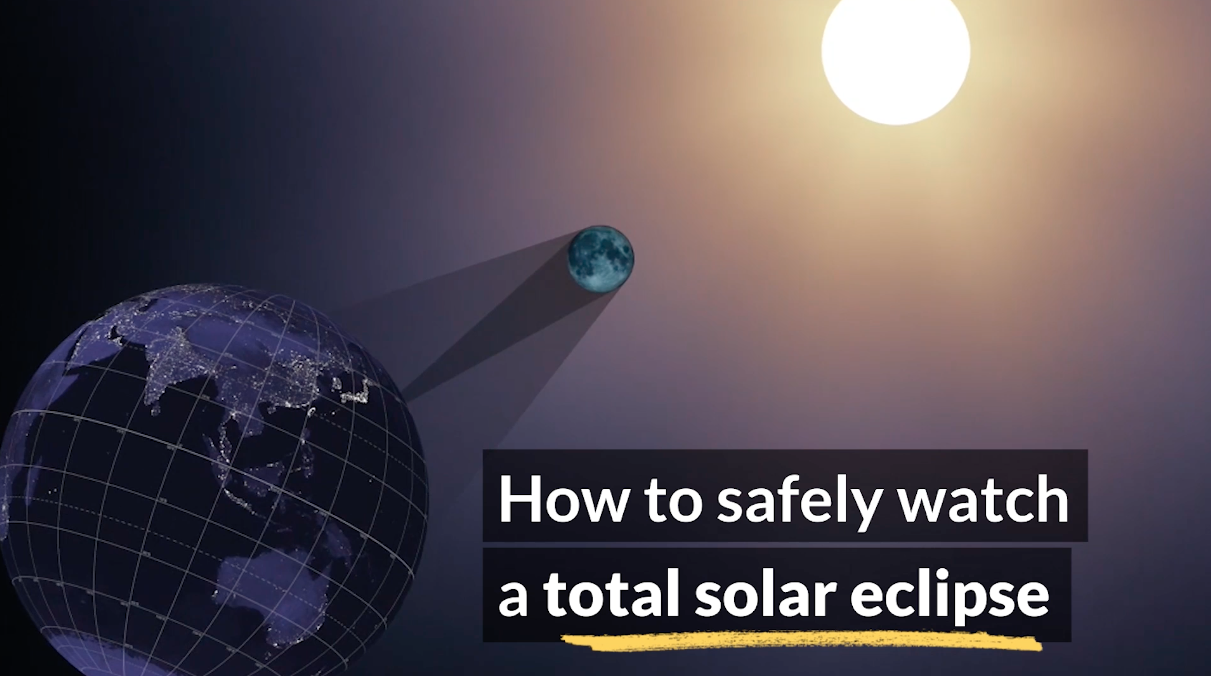Eclipse Safety Imagery 2023
It is never safe to look directly at the Sun – even if the Sun is partially obscured. When watching a partial solar eclipse, you must wear eclipse glasses at all times when looking at the Sun, or use an indirect viewing method. This also applies during a total solar eclipse up until the moment when the Sun is completely blocked by the Moon.
During the short time when the Moon completely obscures the Sun – known as the period of totality – it is safe to look directly at the star without eye protection. However, it’s crucial that you know when it’s safe to both remove and put back on your safe solar viewing glasses.
To learn more about eclipses visit: science.nasa.gov/eclipses.

Watching the annular solar eclipse of October 14, 2023, in Albuquerque, New Mexico, through a solar safe telescope.
Binoculars and telescopes can ONLY be used to look at the Sun or watch an eclipse when used with solar filters specially designed for that purpose. Wearing solar viewing glasses will not protect your eyes when used with binoculars or telescopes – you must have an appropriate filter.
Image Cedit: NASA

A group of people use solar viewing glasses and a solar safe telescope to watch the annular eclipse of October 14, 2023, in Albuquerque, New Mexico.
Binoculars and telescopes can ONLY be used to look at the Sun or watch an eclipse when used with solar filters specially designed for that purpose. Wearing solar viewing glasses will not protect your eyes when used with binoculars or telescopes – you must have an appropriate filter.
Image Credit: NASA/Abbey Interrante

People prepare to watch the annular solar eclipse of October 14, 2023, in Albuquerque, New Mexico, at the Albuquerque International Balloon Fiesta.
Image Credit: NASA/Abbey Interrante

A person watches the annular solar eclipse of October 14, 2023, in Albuquerque, New Mexico, at the Anderson Abruzzo Albuquerque International Balloon Museum.
Binoculars and telescopes can ONLY be used to look at the Sun or watch an eclipse when used with solar filters specially designed for that purpose. Wearing solar viewing glasses will not protect your eyes when used with binoculars or telescopes – you must have an appropriate filter.
Image Cedit: NASA/Jim Spann

Watching the annular solar eclipse of October 14, 2023, in Albuquerque, New Mexico, at the Anderson Abruzzo Albuquerque International Balloon Museum.
Image Credit: NASA/Jim Spann

People watching the annular solar eclipse of October 14, 2023, in Albuquerque, New Mexico, at the Anderson Abruzzo Albuquerque International Balloon Museum.
Image Credit: NASA/Jim Spann

People watching the annular solar eclipse of October 14, 2023, in Albuquerque, New Mexico, at the Anderson Abruzzo Albuquerque International Balloon Museum.
Image Credit: NASA/Jim Spann

A group of NASA employees watch the annular solar eclipse of October 14, 2023, in Kerrville, Texas.
Image Credit: NASA/Liz Landau

People use a telescope to project an image of the Sun in preparation for the annular solar eclipse of October 14, 2023.
Binoculars and telescopes can ONLY be used to look at the Sun or watch an eclipse when used with solar filters specially designed for that purpose. Wearing solar viewing glasses will not protect your eyes when used with binoculars or telescopes – you must have an appropriate filter.
Image Credit: NASA

People use solar viewing glasses to watch the annular eclipse of October 14, 2023.
Image Credit: NASA

People watching the annular solar eclipse of October 14, 2023, in Kerrville, Texas.
Image Credit: NASA

A person watches the annular solar eclipse of October 14, 2023, in Kerrville, Texas.
Image Credit: NASA

A group of people use solar viewing glasses to observe the annular solar eclipse of October 14, 2023, in Kerrville, Texas.
Image Credit: NASA

A group of people use solar viewing glasses to observe the annular solar eclipse of October 14, 2023, in Kerrville, Texas.
Image Credit: NASA

A NASA employee uses solar viewing glasses to safely observe the annular eclipse of October 14, 2023, in Kerrville, Texas.
Image Credit: NASA
For More Information
Credits
Please give credit for this item to:
NASA's Goddard Space Flight Center
-
Producers
- Beth Anthony (KBR Wyle Services, LLC)
- Joy Ng (KBR Wyle Services, LLC)
Release date
This page was originally published on Tuesday, October 31, 2023.
This page was last updated on Tuesday, October 31, 2023 at 10:14 AM EDT.
![Complete transcript available.Music Credit: “Just Vibing Instrumental” by Runone [PRS], Simon Richard Tew [PRS] via Universal Production Music](/vis/a010000/a014500/a014509/14509_EclipsePhases_YT.00060_print.jpg)
![NASA's 2024 Total Solar Eclipse Broadcast (OFFICIAL TRAILER)Music Credit: “Fallout Instrumental” by Christopher James Brett [PRS] via Universal Production MusicComplete transcript available.](/vis/a010000/a014500/a014520/14520_TSEBroadcastTrailer_thumb.png)

![Map Credit: Michala Garrison and the Scientific Visualization Studio (SVS), in collaboration with the NASA Heliophysics Activation Team (NASA HEAT), part of NASA’s Science Activation portfolio; eclipse calculations by Ernie Wright, NASA Goddard Space Flight CenterMusic Credit: “Cascades” by Air Jared [ASCAP], Sebastian Barnaby Robertson [BMI] via Universal Production Music
Watch this video on the NASA Goddard YouTube channel.](/vis/a010000/a014400/a014474/14474_Thumbnail.png)

![Watch this video on the NASA Goddard YouTube channel.Complete transcript available.Music credit: “Easy Breezy” by James Alexander John Welland [PRS] and Thomas Trueman [PRS] from Universal Production Music.](/vis/a010000/a014300/a014395/14395_AreYourEclipseGlassesSafe_Thumbnail.jpg)

![VERTICAL VersionMusic Credit: “Tall Grass” by Jacob Paul Turner [BMI], Marc Pueschl [GEMA], Sebastian Barnaby Robertson [BMI] via Universal Production MusicComplete transcript available.](/vis/a010000/a014300/a014390/AnnularEclipseSafety_Thumbnail-VERTICAL_print.jpg)



![Watch this video on the NASA Goddard YouTube channel.Complete transcript available.Music credit: "Back From The Brink" by Daniel Gunnar Louis Trachtenberg [PRS], “Hive Mind” by Ben De Vries [PRS] and Cam Tigre [PRS] from Universal Production MusicAdditional footage: NASA EDGESound effects: Pixabay](/vis/a010000/a014500/a014532/Thumbnail.jpg)